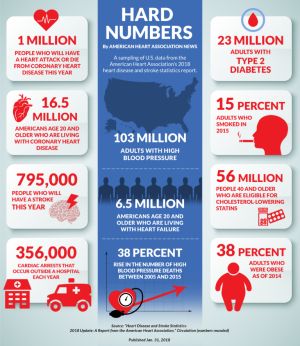
Hispanics/Latinos have higher rates of cardiac dysfunction but are rarely aware they have the heart-pumping problem that can lead to heart failure, according to the journal Circulation: Heart Failure.
American Heart Association researchers found that about half of the 1,818 adults in their study of middle-aged and older Hispanics/Latinos had cardiac dysfunction, yet fewer than 1 in 20 participants knew they had a problem.
Cardiac dysfunction is serious because it can develop into heart failure, a chronic disease in which the heart pumps less blood than the body needs to remain healthy.
“The perception has been that Hispanics/Latinos are a low-risk group for cardiac dysfunction, but that is not true,” said Carlos J. Rodriguez, study senior author and associate professor of medicine and epidemiology at Wake Forest Baptist Medical Center in Winston-Salem, North Carolina.
He noted that the only other large study of cardiac dysfunction in the United States looked at an older, largely non-Hispanic white population and found that about a third had cardiac dysfunction.
In the Echocardiographic Study of Hispanics/Latinos (ECHO-SOL), researchers used ultrasound images of the heart to identify cardiac dysfunction in adults, age 45-74, living in the Bronx, Chicago, Miami and San Diego. Among participants who had high rates of risk factors for cardiac dysfunction:
half were obese;
half had high blood pressure;
two-thirds had diabetes;
two-thirds reported low levels of physical activity; and
one fifth were current smokers.
Researchers noted that these risk factors, along with heart attack, were the same risk factors for progression of cardiac dysfunction to heart failure.
Given the study’s findings, Rodriguez said, health professionals should have “a high level of vigilance” when it comes to monitoring the health of their Hispanic/Latino patients and a “low threshold for intensifying preventative therapies to avoid the possibility of heart failure down the road.”
He added that the earlier the intervention, the better, noting that some studies have suggested that cardiac dysfunction can be reversed by aggressive reduction of risk factors.
ECHO-SOL diagnosed two types of cardiac dysfunction: left ventricular systolic dysfunction (LVSD) and left ventricular diastolic dysfunction (LVDD). In LVSD, the left ventricle, the heart’s largest chamber, does not push blood out to the body as forcefully as it should. In LVDD, the left ventricle is too stiff when relaxed between beats to gather enough blood in its chamber.
Researchers said that the prevalence of the second type, LVDD, was particularly high among Latino-Americans from Central America, whose risk was nearly double that of Mexican-Americans. Researchers said that they did not know whether ancestry or environment explained the difference.
Rodriguez said that because Hispanics/Latinos have been overlooked in previous studies, there are no reliable estimates of how many with cardiac dysfunction will develop heart failure. Researchers plan to continue following ECHO-SOL participants to begin to answer that question.
“Given that Hispanics/Latinos are the largest ethnic minority in the United States, with over 51 million people, they are likely to have a big impact on the heart failure epidemic,” he said.
The U.S. Army Corps of Engineers has been tasked with…
Brown and Caldwell, a leading environmental engineering and construction firm,…
Humboldt State University, one of four campuses within the California…